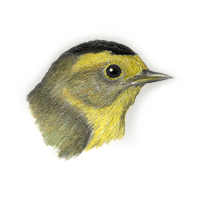 |
Wilson's Warbler
Wilsonia pusilla |
|
|
STANFORD LOCATIONS: Uncommon to fairly common migrant and summer resident in woodland and scrub near the Dish, with a few pairs probably nesting there. Uncommon migrant elsewhere on campus. |
 |
Location |
Type |
Mating System |
Parental Care |
2ndary Diet |
Strategy |
|
|
|
|
I: 10-13 DAYS ALTRICIAL |
|
|
|
TANGLE 0 - 3 feet |
|
MONOG (POLYGYN) |
MF |
.. GLEAN HAWKS BARK .. GLEAN |
| BREEDING: | Thickets and brush in well-watered locations (esp willow and alder bogs), riparian woodland. 1 brood. |
| DISPLAYS: | ? |
| NEST: | Variably placed: high-elevation nests are smaller and built on ground; coastal nests larger and above ground. Bulky, esp for such a small bird; of dead leaves, grass, moss, lined with fine grass, occ hair. Built in 5 days. |
| EGGS: | White to creamy, marked with browns, variable, often wreathed. 0.6" (16 mm). |
| DIET: | Also occ berries. |
| CONSERVATION: | Winters s to w Panama. Uncommon cowbird host. |
| NOTES: | Breeds over a wide range of elevations: coastal populations have smaller clutches, lower nesting success, and are monogamous; high-elevation populations have larger clutches, higher nesting success, and polygyny occurs regularly. Females brood. Much more common in w than in e. |
| ESSAYS: | Polygyny; Monogamy; Average Clutch Size; Variation in Clutch Sizes. |
| REFERENCES: | Stewart et al., 1977. |
| Help | Abbreviations | Species-Alphabetical | Species-Taxonomic | Essays-Alphabetical | |
| Except for Stanford Locations, the material in this species treatment is taken, with permission, from The Birder's Handbook (Paul Ehrlich, David Dobkin, & Darryl Wheye, Simon & Schuster, NY. 1988). | |||||